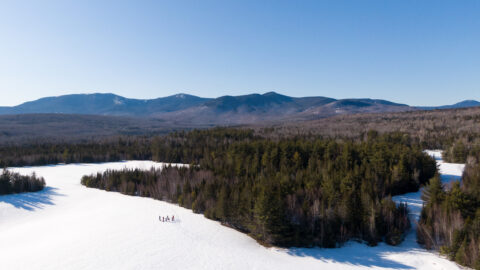A Vision for the Fly Rod Crosby Footpath by Bud Godsoe.
The High Peaks Alliance proposes the construction of a footpath to commemorate the life and accomplishments of Cornelia T. Crosby, known to sports enthusiasts as Fly Rod Crosby. The southern tip of the path is Strong Maine, where she was buried, continues north to Phillips where she was born in 1854, and from there to Rangeley, ending in Oquossoc where she learned her outdoor skills. Her legacy extends beyond hunting and fishing and has significance for recognizing the High Peaks’ potential for tourism, economic development, and conservation.
Fly Rod Crosby was known first for her hunting and fishing abilities. Her competence in the woods earned her local and national respect. She was interested not just as she claimed in catching more fish than any other woman in Maine, but also in the making sure hunting and fishing would last into perpetuity. She worked with others to establish the Maine guides. In fact, Fly Rod was Maine Guide number one.
Fly Rod Crosby became interested in the outdoors largely for health reasons. She combined her writing skills with her interests in the outdoors into marketing Maine for “sports”. She wrote articles about hunting and fishing for the Phillips Phonograph and the Maine Woods. Her newspaper articles and travels made her one of the early promoters of Maine tourism. She attended sportsman’s shows out of state, demonstrating fly-tying and casting. She traveled widely and met other famous people even touring with Annie Oakley of Buffalo Bill’s Wild West Show. She promoted the Central Maine Railway as a way to get to Maine including the Narrow Gauge Railway of Franklin County.
Today, we feel the efforts of Fly Rod Crosby are not only important for supporting the development of outdoor recreation, tourism, and health awareness, but also for uniting communities in the High Peaks area. Her life connects town and townships along the Sandy River from Strong to the Lady of the Lakes Chapel in Oquossoc, where Fly Rod had a hand in fundraising.
We can acknowledge her contributions to history and cultural events by highlighting the history of the towns along the footpath, the sportsman’s’ camps, small town newspapers, the early railroad system in Maine, and unsung Maine women. In keeping with Fly Rod’s legacy we propose a footpath that ties the Strong, Phillips and Rangeley communities to share a common history, culture and to promote outdoor activities.



